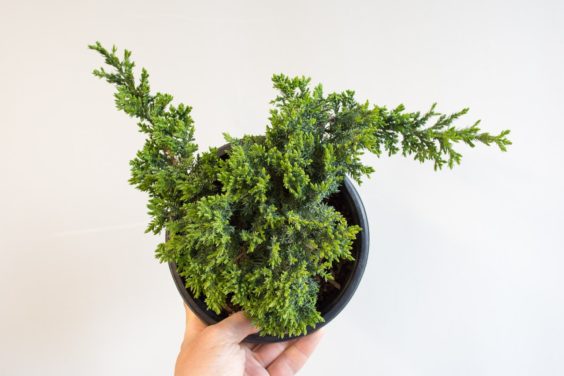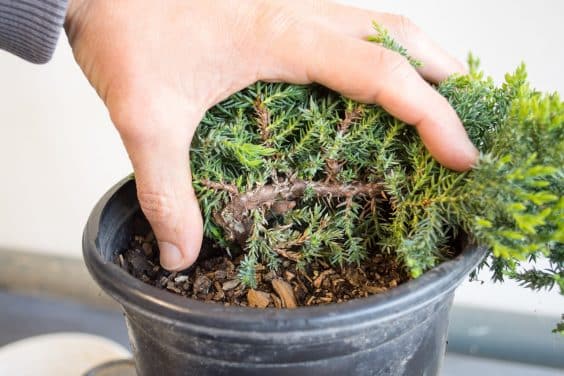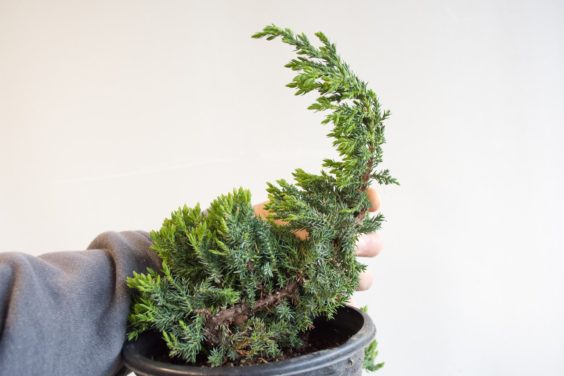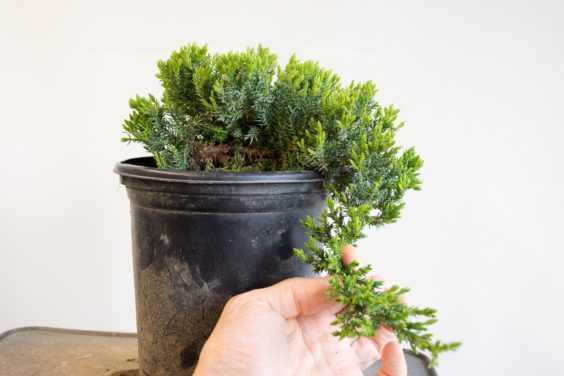When I’m thinking about what trees to add to my collection, I often think about the kinds of problems I enjoy solving. I like developing rough material and turning it into bonsai. I like refining mature specimens. And I like restoring bonsai that may have become unhealthy or grown out of shape due to neglect or infestation.
Different trees can help us answer questions about what we do and don’t like about bonsai, or what we know or would like to learn about it.
If I were new to bonsai, I might have questions like:
- Can I keep a tree alive in my garden?
- Can I keep a tree healthy?
- Can I learn to apply 1 – 3 wires?
- Can I repot a tree without killing it?
- Do I like caring for bonsai?
For answering questions like these, a young procumbens juniper is a great fit. They are hardy, plentiful and inexpensive.
Young procumbens juniper
From above
A view of the trunk
For anyone with more than a passing interest in bonsai, however, the tree can’t offer much beyond help with the questions above. I can’t learn about wiring or styling with such a young specimen, and I can’t expect to display it in an exhibit anytime soon.
Can I plant it in the ground, thicken the trunk for 5-10 years and then start making something of the tree? Yes, but I have little interest in doing that. Put another way, I don’t feel a strong need to answer the following question:
- Can I make improvements to a young procumbens juniper by investing 5-10 years in ground growing followed by refinement work?
Were I new to bonsai and interested in addressing the opening questions, I’d look into my options for improving the young juniper. Because the tree is young and the trunk thin, there are plenty of styling options. With a single wire I could bend the longest shoot to give the tree an upright form.
Bending the trunk up
Or I could bend it down to make a cascade or semi-cascade bonsai.
Bending the trunk down
I could research what it takes to keep procumbens junipers healthy and see if there’s anyone I can rely on when I leave town to ensure the tree gets the water it needs to stay healthy.
Material like this is great for people interested in taking their first bonsai workshop. It’s a less compelling fit, however, for enthusiasts who’ve taken the step of joining a club and have begun to grow their collections. For them, more suitable material is available.
Subscribe to Bonsai Tonight
New Posts Delivered Every Tuesday and Friday





cheryl sykora says
yes. that is the material that MN bonsai society uses for its beginner workshops. Inexpensive, can be manipulated, and gives a person an idea of what is involved in bonsai without breaking the bank. Agree with this.
Larry Smart says
How can I get to parts 2 thru 5? I would like to learn more by continuing the series.
Jonas Dupuich says
Hi Larry – parts 2-5 are on the way and will be delivered, two per week, over the next two weeks.
Jenny says
Where can I buy for example, procubiems juniper or can you recommend something? I am in Calgary.
Jonas Dupuich says
Good question – I don’t know a good source in Canada.
Stefanos says
Yes!
These are the questions that anyone with an interest in bonsai should put to himself before acquiring one. Ignorance and impulsiveness killed many young and also refined bonsai.